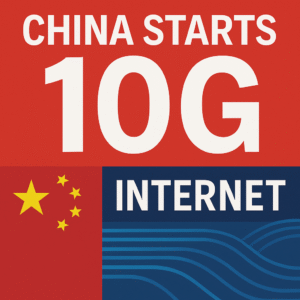
China has officially launched a nationwide 10-gigabit (10G) broadband network, pushing the boundaries of internet speed and connectivity. This milestone marks a leap in how people in China connect, work, and live online. So, what exactly is 10G broadband, and why does it matter?
Wait, What Is 10G Broadband?
No, it’s not the same as 5G wireless. Here’s the difference:
- 5G is for mobile phones and offers faster downloads while on the go.
- 10G broadband is a fixed-line connection that uses fiber-optic cables to deliver internet speeds of up to 10 gigabits per second.
To put that in perspective, with 10G internet, you could download an ultra-high-definition movie in just a few seconds. Even for a household with multiple users streaming, gaming, and working online, lag would become a thing of the past.
Where in China Is 10G Now Available?
The service has already reached over 110 million households across the country. Major cities like Beijing, Shanghai, Guangzhou, and Hangzhou are fully equipped, forming a connected hub that’s ready to support data demands of the future.
China’s Ministry of Industry and Information Technology (MIIT) gave the green light for the commercial rollout during the 2024 Gigabit Broadband Development Forum held in Beijing. The rollout follows two years of preparation, testing, and network upgrades.
Why This Shift to 10G Matters
Think of the internet like a highway. The more cars on the road, the more congestion you get—unless you widen the road. With businesses turning to cloud platforms, students attending virtual classes, and streaming becoming more popular year after year, the digital “traffic” keeps growing.
That’s where 10G broadband comes in. It acts like an eight-lane superhighway where even heavy traffic flows smoothly.
The benefits include:
- Faster Downloads and Uploads: Say goodbye to buffering and slow cloud backups.
- Smoother Video Streaming: 4K and 8K video content loads in a flash.
- Enhanced Remote Work: Stable video calls and lightning-fast access to cloud-based applications.
- Better Online Gaming: Reduced lag means more accurate gameplay and real-time actions.
How Did China Build This Huge Network?
Over the past couple of years, Chinese telecom providers like China Mobile, China Unicom, and China Telecom worked to upgrade the nation’s fiber-optic systems. They invested heavily in laying new fiber lines, adding advanced routers, and improving backbone networks, especially in urban centers.
Interestingly, these aren’t just basic upgrades. We’re talking about cutting-edge, all-optical networks that ensure each connected user gets a stable, ultra-high-speed line right into their homes or offices.
In places like Shanghai, Chengdu, and Wuhan, cities have rolled out pilot zones with 10G internet. Local governments and private businesses are also jumping in, setting up smart city platforms and IoT systems based on these faster connections.
What Can This Network Actually Do?
Beyond home internet, this 10G backbone also sets the stage for truly smart, connected cities. Imagine:
- Autonomous vehicles communicating in real time to avoid accidents.
- Smart factories using real-time data to monitor production.
- Hospitals carrying out remote robotic surgeries with near-zero latency.
This upgrade supports more than just better streaming. It builds the foundation for major technological jumps in everyday life and business operations alike.
Where Does This Put China in Global Rankings?
With this development, China leads in deploying large-scale 10G networks. While other countries have launched 1Gbps or even 2Gbps home services, China’s 10Gbps rollout is nationwide and operational, not just in test or trial mode.
South Korea, the U.S., Japan, and parts of Europe have similar tech in trial or regional stages. But China’s deployment is on another level in terms of scale and readiness.
Real People, Real Impact
Li Jun, a software engineer based in Shanghai, shared his experience after upgrading to 10G broadband. “My company runs large simulations on the cloud. Before, it took hours to upload files. Now, it’s minutes. It completely changed how fast I can work,” he said.
For small businesses and creators, the switch could open doors, too. High-speed connections make it easier to work globally, stream content, and offer services without technical hiccups.
Looking Ahead: What’s Next?
Telecom companies in China are now working on expanding access beyond major cities. Rural areas and second-tier cities are next in line. This expansion ensures that more people can enjoy the benefits of ultra-fast connectivity without being left behind.
Also, talks are already underway about next-generation technologies like “B5G” (beyond 5G) and quantum internet. Networks like the 10G system will serve as the backbone for these future developments.
So, Will You Need 10G Internet?
Maybe not today, but probably very soon. As more devices enter our homes—from smart fridges to virtual reality headsets—the demand for high-speed, stable internet will skyrocket. It’s not just about speed; it’s about being ready for how we’ll live and work in the near future.
Think about how strange it felt the first time we went from 3G to 4G. Now, it’d be hard to imagine using 3G for anything more than a text. That’s the kind of shift 10G could bring to home and office internet.
Conclusion
China’s move to launch the world’s first large-scale 10G broadband network sets a powerful example. It shows what’s possible with strong investment, clear planning, and a focus on digital infrastructure. From individual homes to entire industries, this kind of connection will play a huge role in shaping the connected world of tomorrow.
If other countries follow the same path, we could see a global internet transformation sooner than expected. The future of how we connect just got a lot faster—and China is leading the charge.


